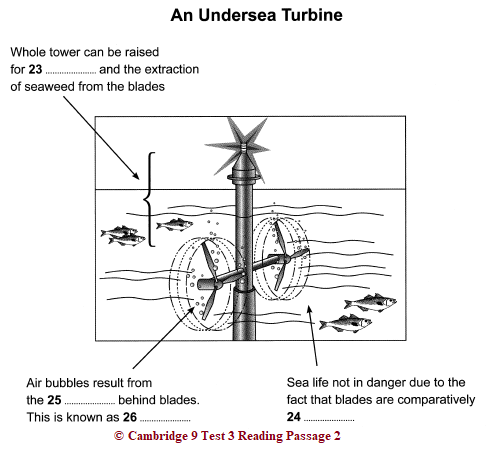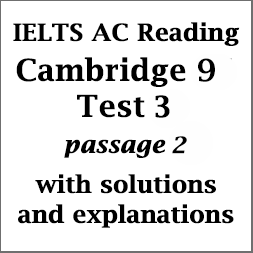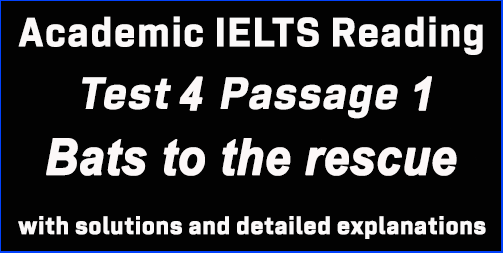IELTS Academic Reading: Cambridge 9, Test 3: Reading Passage 2; Tidal Power; with best solutions and detailed explanations
This IELTS Reading post focuses on all the solutions for IELTS Cambridge 9 Test 3 Reading Passage 2 which is entitled ‘Tidal Power‘ . This is a post for candidates who have major problems in finding Reading Answers. This post can guide you the best to comprehend each Reading answer without facing much difficulty. Tracing IELTS Reading answers is a slow process and I sincerely hope this post can assist you in your IELTS Reading preparation.

IELTS Cambridge 9 Test 3: AC Reading Module
Reading Passage 2:
The headline of the passage: Tidal Power
Questions 14-17 (Identifying information):
[This question asks you to find information from the passage and write the number of the paragraph (A, B, C or D … .. ) in the answer sheet. Now, if the question is given in the very first part of the question set, I’d request you not to answer them. It’s mainly because this question will not follow any sequence, and so it will surely kill your time. Rather, you should answer all the other questions first. And just like List of Headings, only read the first two lines or last two lines of the expected paragraph initially. If you find the answers, you need not read the middle part. If you don’t find answers yet, you can skim the middle part of the paragraph. Keywords will be a useful matter here.]
Question 14: the location of the first test site
Keywords for the question: location, first test site,
The location of the first site is given in paragraph C where writer states, “The first station is expected to be installed off Lynmouth in Devon shortly to test the technology in a venture jointly funded by the department of Trade and Industry and the European Union.”
So, the answer is: C
Question 15: the way of bringing the power produced on one site back into Britain
Keywords for the question: bringing, power produced, site, back into Britain,
In paragraph E, the author mentions, “Dr Bahaj has done most work on the Alderney site, where there are powerful currents. The single undersea turbine farm would produce far more power than needed for the Channel Islands and most would be fed into the French Grid and be re-imported into Britain via the cable under the Channel.”
Here, re-imported into Britain = back into Britain,
So, the answer is: E
Question 16: a reference to a previous attempt by Britain to find an alternative source of energy
Keywords for the question: previous attempt, by Britain, find an alternative source,
In paragraph A, the writer says, “Unlike wind power, which Britain originally developed and then abandoned for 20 years allowing the Dutch to make it a major industry, undersea turbines could become a big export earner to island nations such as Japan and New Zealand”.
The lines indicate to the fact that the British made a previous attempt to use wind power as a sustainable and alternative source of energy, though they were not successful and they abandoned this attempt for 20 years.
So, the answer is: A
Question 17: mention of the possibility of applying technology from another industry
Keywords for the question: possibility, applying technology, another industry,
In paragraph C, we can see the mention of possible use of a technology, “The technology for dealing with the hostile saline environment under the sea has been developed in the North Sea oil industry and much is already known about .. . ….”
So, another industry which has used the technology is the North Sea oil industry.
So, the answer is: C
Questions 18-22: (Choosing options (claims) from given statements)
[In these questions candidates have to choose some options from the given statements. These questions will not follow any sequential orders so candidates need to apply their skills of skimming by reading the statements and finding the correct keywords. ]
Which FIVE of the following claims about tidal power are made by the writer?
In paragraph A, the writer talks about tidal power and says, “…. . . . . unlike wind, the tides are predictable and the power input is constant (A). This technology raises the prospect of Britain becoming self-sufficient in renewable energy and drastically reducing its carbon dioxide emissions (D). If tides, wind and wave power are all developed, Britain would be able to close gas, coal and nuclear power plants (E) and export renewable power to other parts of Europe (F).”
Again, in the end of paragraph C, the writer indicates that “The best sites are between islands or around heavily indented coasts where there are strong tidal currents. (J) ”
Here, reliable = predictable, cut down = reduce, plants = stations, a means of increasing national income = export earner,
So, the tides are predictable and the power input is constant = It is a more reliable source of energy than wind power (option A), drastically reducing its carbon dioxide emissions = It would cut down air pollution (option D), Britain would be able to close gas, coal and nuclear power plants = It would contribute to the closure of many existing power stations in Britain (option E), export renewable power to other parts of Europe = It could be a means of increasing national income (option F), The best sites are between islands or around heavily indented coasts where there are strong tidal currents = It is best produced in the vicinity of coastlines with particular features (option J).
So the answers are: (in any order) A, D, E, F, J,
Questions 23-26 (Labeling a diagram)
[In this type of question, candidates are asked to label a diagram with NO MORE THAN TWO WORDS from the passage. Keywords are important to find answers correctly. Generally, this type of question maintains a sequence. However, we should not be surprised if the sequence is not maintained. Find the keywords in the passage and you are most likely to find the answers.]

Question 23: Whole tower can be raised for __________ and the extraction of seaweed from the blades
Keywords for this question: can be raised, extraction of seaweed,
Here, our main keyword is ‘extraction of seaweed’. We can find the mention of seaweed at the end of Section D. The writer says, “The towers will stick out of the water and be lit, to warn shipping, and also be designed to be lifted out of the water for maintenance and to clean seaweed from the blades.”
Here, lifted out = raised, clean seaweed = the extraction of seaweed,
So, the answer is: maintenance
Question 24: Sea life not in danger due to fact that blades are comparatively ____________ .
Keywords for this question: sea life, not in danger, blades are comparatively,
Here, our main keywords are sea life and not in danger which can be found in Section D, in the middle of the paragraph. “. . .. Fish and other creatures are thought unlikely to be at risk from the relatively slow-turning blades.”
Here, Fish and other creatures = sea life, unlikely to be at risk = not in danger, relatively = comparatively,
So, the answer is: slow / slow-turning
Questions 25 & 26: Air bubbles result from the _________ behind blades. This is known as __________.
Keywords for this question: air bubbles, result from, behind blades, known as,
Here, in these questions, the main keywords are air bubbles and result from which can be found in Section F. Let’s have a look there, “One technical difficulty is cavitation, where low pressure behind a turning blade causes air bubbles.”
Here, causes = result from,
So, the answers are:
- low pressure
- cavitation
Click here for solutions to Cambridge 9 Test 3 Reading Passage 1
Click here for solutions to Cambridge 9 Test 3 Reading Passage 3




One thought on “IELTS Academic Reading: Cambridge 9, Test 3: Reading Passage 2; Tidal Power; with best solutions and detailed explanations”